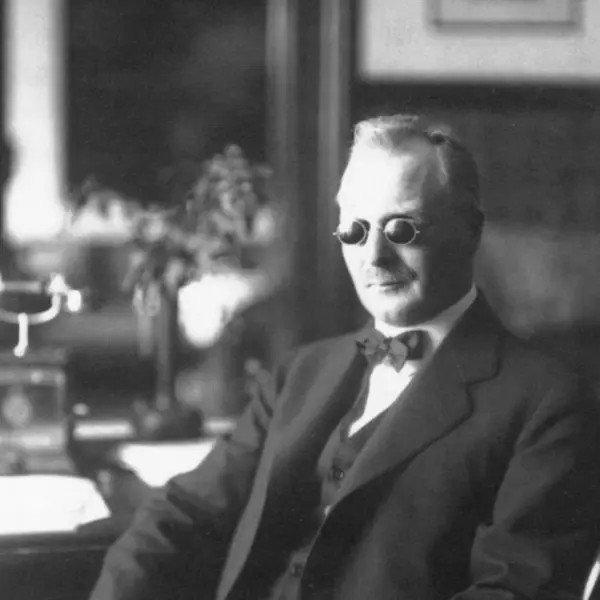Here is a list of distinguished alumni who have made, or are making, a positive impact on society, both nationally and internationally.
Graduates of the 19th Century
Gunnar Knudsen, 1867

Gunnar Knudsen was Norway’s Prime Minister from 1908 to 1910 and again from 1913 to 1920, as well as a prominent shipowner and industrialist. After studying engineering at Chalmers in Gothenburg, he returned to Skien to develop his family’s shipyard and shipping business. He built modern steamships and engaged in the nation’s infrastructure and maritime policy. As a politician in the Liberal Party (Venstre), he advocated for democratic reforms and social responsibility. During the First World War, he skilfully navigated Norway’s neutrality and strengthened the country’s economic independence.
Hilmer Kollén

Hilmer Kollén was the inventor of the folding carpenter’s ruler. In 1883, he patented his so-called comparison ruler, featuring both inch and centimeter scales. Shortly thereafter, he developed the classic measuring stick with hinged joints, a design that made the tool both practical and durable. Kollén founded the Swedish Measure and Folding Ruler Factory, first in Stockholm and later in Gothenburg and Hultafors. His patented design spread quickly and is still used worldwide today, virtually unchanged, as an indispensable tool for craftsmen and engineers.
Hans Hedlund, 1875

Hans Hedlund was one of Gothenburg’s most influential architects at the turn of the 20th century. He designed several of the city’s most well-known buildings, including the Market Hall on Kungstorget, still today a vibrant meeting place and an architectural landmark, and the Art Nouveau-inspired “Tomtehuset.” As Chalmers’ first professor of building design, he shaped generations of architects. Hedlund’s style was characterized by skilled craftsmanship, functional solutions, and inspiration from international trends, giving Gothenburg a distinctive and enduring architectural identity.
J. Sigfrid Edström, Electrical Engineering 1891

Edström was one of Sweden’s most influential industrial leaders and sports figures. As head of Gothenburg’s tramways from 1896 to 1903, he led the electrification of the city’s public transport. He served as CEO of ASEA from 1903 to 1933 and as chairman of the board until 1949, during a period of strong technological development. Edström was president of the International Olympic Committee from 1946 to 1952. As chairman of the Swedish Employers’ Confederation, he signed the Saltsjöbaden Agreement in 1938. Through his leadership, he helped shape both Swedish industry and international sport.
Gustaf Dalén, Mechanical Engineering 1896

Gustaf Dalén was an engineer, inventor, and Nobel Prize laureate in Physics in 1912. He developed AGA lighthouse technology, including the sun valve, which made maritime navigation safer worldwide, and also designed the well-known AGA cooker. As CEO of AB Gas-Accumulator, he led the company to international success. Even after losing his sight in an accident, he continued working with undiminished energy and creativity. Dalén donated a large part of his Nobel Prize to scholarships for talented students, and his motto “Be an optimist!” lives on as a testament to his forward-looking spirit.
Graduates of the 20th Century
Vera Sandberg, Chemical Engineering 1917

Vera Sandberg became Sweden’s first female engineer in 1917 — a true pioneer in the world of technology. She was admitted to Chalmers in 1914 through a special mathematics entrance examination, which was then required for women. After graduating, she worked as head of the laboratory at the Scandinavian Refinery in Partille, and later at factories in Karlshamn and Helsingborg. She was subsequently employed at Sieverts Cable Works in Sundbyberg, where she contributed to developments in electrical engineering and materials. Her life is celebrated today in many places at Chalmers.
Marianne Kärrholm, Chemical Engineering 1945

Marianne Kärrholm became Chalmers’ first female professor in 1984, in Consumer Technology. She earned her MSc in Chemical Engineering from Chalmers in 1945 and a PhD in 1960 on wool dyeing, becoming Associate Professor in Textile Chemistry the same year. Kärrholm worked at the Textile Research Institute until 1971 before leading the Swedish National Board for Technical Development’s consumer technology group. This work became established at Chalmers, leading to the Department of Consumer Technology. Her leadership broadened technology’s role in addressing everyday needs and consumer issues.
Gert Wingårdh, Arkitektur 1975

Gert Wingårdh is an architect graduated from Chalmers in 1975 and awarded an honorary doctorate in 1999. Founder of Wingårdh Arkitektkontor and one of Sweden’s most prominent architects, with works such as Aula Medica in Stockholm, Universeum in Gothenburg, and the extension of Liljevalchs Art Gallery. Recipient of numerous awards, including multiple Kasper Salin Prizes and international recognition such as the World Architecture Festival Award. His work has been praised for both artistic excellence and technical innovation. Known to the public through the Swedish television series Husdrömmar.
This list is by no means complete, and more outstanding alumni will be added over time. Do you have a suggestion for someone who should be included? We would be delighted to hear from you at alumni@chalmers.se